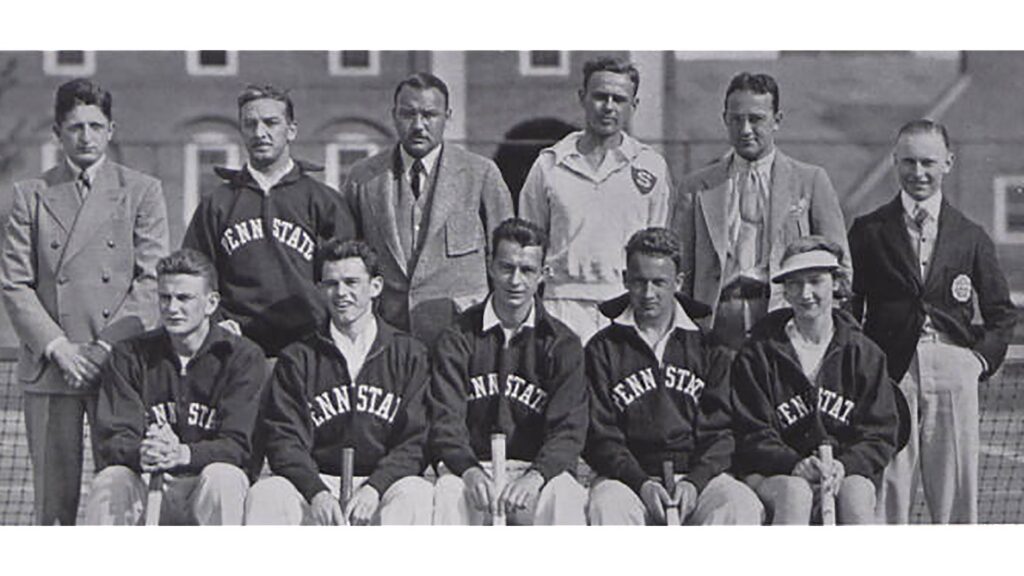Dorothy “Dot” Anderson was the first and only woman to earn a Penn State “Varsity-S” letter for her feats on a men’s athletic team.
The dynamic tennis player attended Butler High School in Western Pennsylvania. Although tennis enjoyed limited popularity in the region, Anderson began playing in the fourth grade and found opportunities to compete in local and regional tournaments sponsored by the United States Lawn Tennis Association. In 1927, as a 15-year-old, Anderson made her debut in a losing effort in the singles finals of the Northwestern Pennsylvania Lawn Tennis Association championship in Oil City.
In the fall of 1930, Anderson enrolled at Carnegie Tech in Pittsburgh where coaches recruited her to play on the men’s intercollegiate squad. However, the dean of women denied her request to join the freshman tennis team, even though a New York Times columnist concluded that Anderson would have been the number two player on the team.
After leaving Carnegie Tech when the school denied her request to play on the men’s team, sports columnists predicted a bright future for the 19-year-old after she won the 1931 Northwest Pennsylvania tournament, a feat she repeated in 1932 and 1933. In 1932, Anderson also prevailed at the Western Pennsylvania championship. Seeking to further her tennis career, she spent the next two years playing on Southern California’s highly competitive tennis circuit where she enjoyed only modest success.

In the fall of 1933, Anderson arrived at Penn State, ranked as one of the top women’s players in Western Pennsylvania. Harvey W. “Dink” Stover, Penn State’s men’s tennis coach, recruited Anderson to play for his varsity team, recognizing that her skill and novelty as a woman playing on the men’s team might bring more fans to Penn State matches in an era in which the Great Depression ravaged intercollegiate athletic budgets.
Penn State’s Dean of Women Charlotte Ray and Athletic Director Hugo Bezdek supported Anderson’s petition to compete and during her senior year in 1935, she joined the men on the Nittany Lion varsity team. That May, Anderson won her first match against Carnegie Tech in front of a large crowd. She went on to earn victories against male opponents from Bucknell, Gettysburg, Johns Hopkins, Dickinson, and Syracuse.
A controversy erupted when the United States Naval Academy’s athletic director refused to allow his men to play against a woman. Anderson’s only loss of the season came from her Cornell opponent during the season finale. For her efforts, Penn State honored her with a varsity letter, an event that made national headlines.
Amateur tennis was an expensive endeavor, and Anderson could not afford to continue playing. She returned to Butler where she taught at the local high school before marrying and moving to Wisconsin. Anderson got back into amateur tennis and won several Wisconsin women’s championships. She died in 2001 at the age of 89.
Anderson’s one-year career at Penn State had a few immediate implications. Until the early 1960s, intercollegiate sport almost entirely excluded women. Still, between 1935 and 1955 at least five other women enjoyed some successes on men’s intercollegiate tennis squads in Western Pennsylvania. In 1964, Penn State’s athletic administration invoked Anderson’s pioneering efforts when it inaugurated a women’s tennis team as a part of the new women’s athletic program.
Jacob Fredericks & Mark Dyreson
Sources:
Slotcavage, Tommy and Mark Dyreson. “Anomaly or Harbinger? Penn State’s 1935 Female “Letter ‘Man’” and New Frontiers in the History of Women’s Intercollegiate Sport in the United States,” The International Journal of the History of Sport 36, nos. 17-18 (2019): 1574-1611.
Dorothy Anderson file, Pennsylvania State University. Intercollegiate Athletics, Athlete and Athletics Personnel Files, 1875-2016, 477, Eberly Family Special Collections Library.
First Published: July 28, 2021
Last Modified: September 26, 2021
